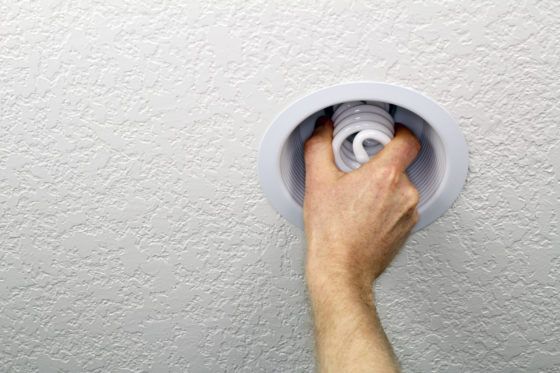Compact fluorescent lightbulbs contain mercury and must be handled with care — both at home and in the recycling facilities where they are broken down.

Photo credit: iStock.com/Serenethos
Even though LED lights and bulbs are becoming more and more common, enter any household and you’re likely to still see compact fluorescent lightbulb (CFLs) in use.
Geoff Clark, a senior occupational hygienist at WorkSafeBC, advises people to keep the original packaging from the CFLs they buy. When one burns out, you can put it back in the original packaging, and return it to the place you bought it for recycling.
An important thing to bear in mind about CFLs — and fluorescent ceiling light tubes — is that they contain a small amount of mercury. This isn’t an issue if the bulb is intact, but if it breaks, the mercury can be released into the air or contact the skin. Even though a single bulb breaking may not be a big health hazard, the small amount of mercury in it could harm a young child or a pet.
How to safely clean up broken CFLs at home
Of course it’s best to avoid breaking CFLs — but if it happens, proper clean-up is important.
If a CFL does break, ventilate the area by opening all the windows and doors to the outside, then keep everyone away from the area for at least 15 minutes. Do not use a vacuum because it will blow the mercury into the air. To handle the broken pieces, wear disposable gloves and follow the safe procedures described in How to safely clean up a broken CFL from Health Canada.
CFL safety at work
Families and pets at home aren’t the only ones at risk of exposure to mercury from broken CFLs. It’s also a hazard for workers at recycling facilities who break down CFLs and fluorescent tubes.
Geoff told me more about how CFLs and fluorescent tubes are broken down: workers lower the bulbs into the top of a big drum machine with a spinning, metal wire inside. As the wire spins, it smashes through the bulbs like a salami slicer. Once the bulbs are pulverized, the glass, aluminum, and mercury can be recycled or reused in things like ceramic tile, scrap metal, and thermostats, respectively.
Employers need to ensure there is adequate ventilation in the work area, and that the drums have fans that draw air out through a HEPA filter. They also need to make sure workers use protective clothing, gloves, masks, and respirators, and undergo a decontamination process before leaving the work area. In addition, safe work procedures are required when opening the drum or replacing the filter.
Long-term exposure to mercury is a health risk that can lead to kidney damage, vision changes, hearing loss, central nervous system problems, and more. See WorkSafeBC’s webpage on Mercury for more information.
For more on safety in the recycling industry, see my posts Sorting out workplace safety in the waste and recycling industry and Gearing up against noise exposure in recycling facilities.


